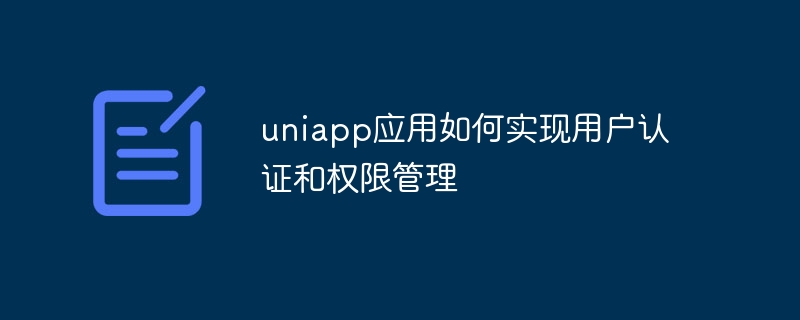

How uniapp application implements user authentication and permission management
With the development of mobile applications, user authentication and permission management have become essential functions. uniapp provides a convenient and fast way to implement user authentication and permission management. This article will introduce how the uniapp application implements user authentication and permission management, and give corresponding code examples.
1. Implementation of user authentication function
User authentication is the process of verifying user identity, which can be used to distinguish user permissions and protect resource security. In uniapp, user authentication can be achieved by using plug-ins or developing it yourself.
There are some commonly used user authentication plug-ins in uniapp, such as the uni-id plug-in. The uni-id plug-in is a user authentication plug-in based on cloud functions. It provides user registration, login, password retrieval and other functions. It also supports third-party login, such as WeChat, Alipay, etc.
The specific implementation steps are as follows:
(1) Install the uni-id plug-in
In the uniapp project, open the terminal and execute the following command to install the uni-id plug-in:
npm install uni-id
(2) Introduce the uni-id plug-in
In the page that requires user authentication, introduce the uni-id plug-in:
import uniID from '@/uni-id/uni-id.js'
(3) Use uni-id Plug-in for user registration and login
In the logical part of the page, you can use the registration and login methods provided by the uni-id plug-in to complete user authentication:
uniID.register({
username: '张三',
password: '123456'
})
.then(res => {
// 注册成功的逻辑处理
})
.catch(err => {
// 注册失败的逻辑处理
})
uniID.login({
username: '张三',
password: '123456'
})
.then(res => {
// 登录成功的逻辑处理
})
.catch(err => {
// 登录失败的逻辑处理
})If the plug-in in uniapp does not meet the needs, you can also develop the user authentication function yourself.
The specific implementation steps are as follows:
(1) Create the user authentication interface
To create the user authentication interface in the cloud function, you can use uniCloud, DCloud cloud development, etc.
(2) Call the user authentication interface in uniapp
To call the user authentication interface in uniapp, use uni.request or uniCloud.callFunction to call.
2. Implementation of the permission management function
Permission management is to control the user's access to and operations on resources based on the user's role and permissions. In uniapp, you can use vuex for permission management.
In the store directory in the uniapp project, create the vuex module for permission management.
// permission.js
const state = {
roles: [], // 用户角色信息
permissions: [] // 用户权限信息
}
const mutations = {
SET_ROLES(state, roles) {
state.roles = roles
},
SET_PERMISSIONS(state, permissions) {
state.permissions = permissions
}
}
const actions = {
setRoles({commit}, roles) {
commit('SET_ROLES', roles)
},
setPermissions({commit}, permissions) {
commit('SET_PERMISSIONS', permissions)
}
}
export default {
namespaced: true,
state,
mutations,
actions
}After the user logs in successfully, the role and permission information can be set based on the user's identity information and Stored in vuex:
import store from '@/store'
const roles = ['admin'] // 用户角色信息
const permissions = ['create', 'update', 'delete'] // 用户权限信息
store.dispatch('permission/setRoles', roles)
store.dispatch('permission/setPermissions', permissions)In pages that require permission control, you can use the roles and roles stored in vuex Permission information is used to determine whether the user has permission to perform related operations:
import { mapState } from 'vuex'
export default {
computed: {
...mapState('permission', ['roles', 'permissions'])
},
methods: {
hasPermission(permission) {
return this.permissions.includes(permission)
}
}
}The above is an introduction to how the uniapp application implements user authentication and permission management. User login, registration and permission control can be easily achieved by using plug-ins or self-development. Hope this article can be helpful to you.
The above is the detailed content of How does the uniapp application implement user authentication and permission management?. For more information, please follow other related articles on the PHP Chinese website!
 How to restore videos that have been officially removed from Douyin
How to restore videos that have been officially removed from Douyin
 js method to generate random numbers
js method to generate random numbers
 How high will Ethereum go?
How high will Ethereum go?
 How to recover deleted files on computer
How to recover deleted files on computer
 How many years do you have to pay for medical insurance to enjoy lifelong medical insurance?
How many years do you have to pay for medical insurance to enjoy lifelong medical insurance?
 What to do if there is no cursor when clicking on the input box
What to do if there is no cursor when clicking on the input box
 What should I do if English letters appear when I turn on the computer and the computer cannot be turned on?
What should I do if English letters appear when I turn on the computer and the computer cannot be turned on?
 How to create virtual wifi in win7
How to create virtual wifi in win7




